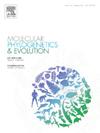利用定向超保守元件数据研究直翅目昆虫的系统发育。
IF 3.6
1区 生物学
Q2 BIOCHEMISTRY & MOLECULAR BIOLOGY
引用次数: 0
摘要
超保守元件靶捕获(UCEs)是昆虫系统基因组研究中广泛使用的一种技术,针对不同的昆虫目开发了不同的探针组。然而,这种方法在直翅目中的应用仍未得到探索。在这项研究中,我们设计了一个新的探针集,利用注释的直翅目基因组捕获UCE位点。我们设计的诱饵套装“Orthoptera-UCEbaitset-v1”包含15,651个探针,每个探针120 bp,靶向1,361个UCE位点。我们通过从公开可用的直翅目基因组和转录组数据集中识别和提取UCE位点,在计算机上测试了我们的探针集,此外,为将UCE方法应用于直翅目系统基因组学提供了替代方案。从UCE计算机测试得到的系统发育得到了很好的支持,并且与该群体的当前分类高度相似,该分类得到了采用不同证据来源的各种研究的支持。在这项研究中,我们表明基于UCEs的方法提供了一个令人信服的替代外显子基因组靶向,因为UCEs跨越外显子,内含子和基因间区域,为直翅目系统基因组学提供了一个强大的和适应性强的解决方案。此外,使用成熟的探针设计和UCE位点捕获方法使得这种方法既有效又可扩展,这对于直翅目来说尤其有价值,直翅目以其具有挑战性的基因组特征而闻名,包括许多物种的大基因组大小。然而,必须考虑到单一策略可能不是该昆虫类群系统基因组学的普遍最佳策略,需要进一步的研究来评估和整合不同的方法来推进直翅目系统基因组学的研究。本文章由计算机程序翻译,如有差异,请以英文原文为准。

Phylogeny of Orthoptera (Insecta) using targeted ultraconserved element data
Target capture of Ultraconserved Elements (UCEs) is a widely used technique in insect phylogenomic research, with various probe sets developed for different insect orders. However, the use of this approach in the order Orthoptera remains unexplored. In this study, we designed a novel probe set to capture UCE loci in Orthoptera by leveraging annotated Orthoptera genomes. Our designed bait set “Orthoptera-UCEbaitset-v1” contains 15,651 probes of 120 bp each, targeting 1,361 UCE loci. We tested our probe set in-silico by identifying and extracting UCE loci from publicly available genomic and transcriptomic datasets of Orthoptera and additionally, provide alternatives for applying the UCE approach to Orthoptera phylogenomics. The resulting phylogeny from the UCE in-silico test was well-supported and highly similar to the current classification for the group, which is supported by various studies employing diverse sources of evidence. In this study we show that the UCE-based approach provides a compelling alternative to exonic-only genomic targeting, as UCEs span exonic, intronic, and intergenic regions, offering a robust and adaptable solution for Orthoptera phylogenomics. Furthermore, the use of well-established methodologies for probe design and UCE loci capture makes this approach both efficient and scalable, which is particularly valuable for Orthoptera, a group known for its challenging genomic characteristics, including the large genome sizes of many species. Nevertheless, it is crucial to consider that a single strategy may not be universally optimal for phylogenomics of this insect group, and that further studies are needed to evaluate and integrate different approaches for advancing phylogenomic research in Orthoptera.
求助全文
通过发布文献求助,成功后即可免费获取论文全文。
去求助
来源期刊
CiteScore
7.50
自引率
7.30%
发文量
249
审稿时长
7.5 months
期刊介绍:
Molecular Phylogenetics and Evolution is dedicated to bringing Darwin''s dream within grasp - to "have fairly true genealogical trees of each great kingdom of Nature." The journal provides a forum for molecular studies that advance our understanding of phylogeny and evolution, further the development of phylogenetically more accurate taxonomic classifications, and ultimately bring a unified classification for all the ramifying lines of life. Phylogeographic studies will be considered for publication if they offer EXCEPTIONAL theoretical or empirical advances.

 求助内容:
求助内容: 应助结果提醒方式:
应助结果提醒方式:


